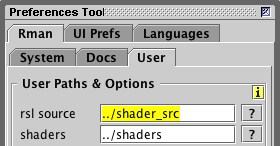Introduction
Over and above the complications of writing RSL2 shaders - compared to
writing classic shaders - coding a physically plausible shader presents a
significant challenge because of the need to understand the order in
which shader methods are called and how data is
accumulated as a result of a material, light sources and Pixar's "integrators"
working cooperatively to form a shading pipeline.
To illustrate the interactions that occur between a material and a light source two of
the sample shaders provided by Pixar,
Pixar/RenderManProServer-18.0/lib/rsl/shaders/helloAS.sl
Pixar/RenderManProServer-18.0/lib/rsl/shaders/plausibleArealight.sl
were "peppered" with printf() statements. For example,
public void diffuselighting(output color Ci, Oi) {
printf("material: diffuselighting() start\n");
printf("material: diffuselighting() calling directlighting()\n");
Ci += directlighting(this, getlights());
if(diffuseSamples > 0) {
printf("material: diffuselighting() calling indirectspecular()\n");
Ci += m_diffuse->m_diffColor * indirectdiffuse(P, m_shadingCtx->m_Nn,
diffuseSamples);
}
printf("material: diffuselighting() finish\n");
}
The helloAS.sl (uses the Ashikhmin/Shirley shading model) and
plausibleArealight.sl source files were copied to Cutter's rsl source
directory and re-compiled.

Figure 1
Locations where Cutter expects to find rsl source files and
where it directs Pixar's shader compiler to put .slo files.
The rib file shown below was used to generate the output of the printf() statements. To reduce the quantity of text the material shader was assigned to a single point - it is shaded only once when the hider is set to "hidden".
Listing 1 (dataflow.rib)
Option "searchpath" "shader" "@:../shaders"
Option "searchpath" "texture" "@:../textures"
#Hider "raytrace"
Hider "hidden"
Display "point_dataflow" "it" "rgba"
Format 640 360 1
Projection "perspective" "fov" 20
ShadingRate 1
Translate 0 0 3
Rotate 0 1 0 0
Rotate 0 0 1 0
Scale 1 1 -1
WorldBegin
Attribute "visibility" "int specular" [1] "int diffuse" [1]
"int transmission" [1]
TransformBegin
Translate 0 0 2
Scale 4 4 1
LightSource "plausibleArealight" 3
"float intensity" 2
"color lightcolor" [1.0 1.0 1.0]
"float minSamples" 4
"float maxSamples" 8
"float sides" 2
TransformEnd
AttributeBegin
Surface "helloAS" "float specularSamples" 4
"float diffuseSamples" 8
"float specularGain" 0.6
ShadingInterpolation "constant"
Points "P" [0 0 0] "constantwidth" [0.2]
AttributeEnd
WorldEnd
|
Because the edited versions of helloAS.sl and plausibleArealight.sl also printed the values of the data contained in the array of __radiancesample structs the "min" and "max" sampling of light were reduced to 4 and 8. Likewise, the rib values of "specularSamples" and "diffuseSamples" were reduced.